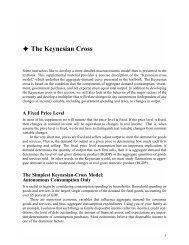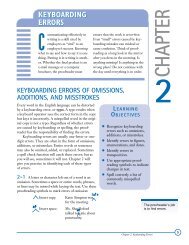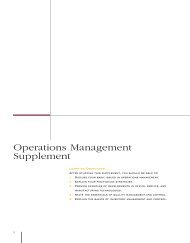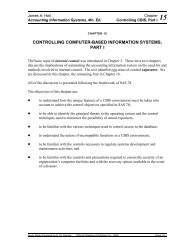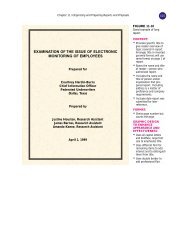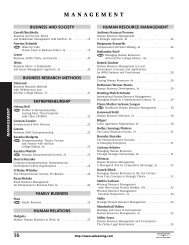chapter 8: strategy formulation and implementation
chapter 8: strategy formulation and implementation
chapter 8: strategy formulation and implementation
You also want an ePaper? Increase the reach of your titles
YUMPU automatically turns print PDFs into web optimized ePapers that Google loves.
In many cases, implementing a new <strong>strategy</strong> requires making changes in<br />
organizational structure, such as adding or changing positions, reorganizing<br />
to teams, redesigning jobs, or shifting managers’ responsibility <strong>and</strong> accountability.<br />
For example, a cereal manufacturing company that wanted to reduce<br />
costs <strong>and</strong> improve efficiency to pursue a low-cost leadership <strong>strategy</strong> revised<br />
task design by combining several packing positions into one job <strong>and</strong> crosstraining<br />
employees to operate all of the packing line’s equipment. This<br />
reduced the number of workers needed during peak times <strong>and</strong> avoided leaving<br />
some workers idle during slow periods. The structural changes cut overall<br />
plant costs <strong>and</strong> manufacturing expenses while significantly increasing the<br />
factory’s productivity <strong>and</strong> yield, thus helping to implement the new <strong>strategy</strong>.<br />
69 At Limited Inc., a chain of specialty stores including Express <strong>and</strong><br />
Victoria’s Secret, founder <strong>and</strong> chairman Leslie Wexner decided to shift to a<br />
centralized organizational structure to implement a differentiation <strong>strategy</strong>.<br />
Limited was losing its fashion direction <strong>and</strong> customer insight, with many different<br />
stores pursuing their own goals <strong>and</strong> ideas. The new centralized structure,<br />
which includes a “corporate brain trust” of executives who oversee<br />
design, marketing, <strong>and</strong> distribution across the company’s nearly 5,000 stores,<br />
has gotten the company refocused. 70<br />
Information <strong>and</strong> Control Systems<br />
Information <strong>and</strong> control systems include reward systems, pay incentives, budgets<br />
for allocating resources, information technology systems, <strong>and</strong> the organization’s<br />
rules, policies, <strong>and</strong> procedures. Changes in these systems represent<br />
major tools for putting <strong>strategy</strong> into action. For example, managers can reassign<br />
resources from research <strong>and</strong> development to marketing if a new <strong>strategy</strong><br />
requires increased advertising but no product innovations. Managers <strong>and</strong><br />
employees must also be rewarded for adhering to the new <strong>strategy</strong> <strong>and</strong> making<br />
it a success. 71<br />
At ConAgra, maker of Healthy Choice <strong>and</strong> Banquet br<strong>and</strong>s, top executives<br />
instituted top-down cost controls in the corporation’s operating units <strong>and</strong> developed<br />
new systems for pooling resources to reduce purchasing, warehousing, <strong>and</strong><br />
transportation costs. To ensure that managers embraced the new <strong>strategy</strong> of<br />
cooperation <strong>and</strong> efficiency, leaders tied 25 percent of their bonuses directly to<br />
savings targets. Division heads saved $100 million in the first fiscal year. Top<br />
leaders also made changes in information systems by introducing a computerized<br />
network to track how much suppliers charge each ConAgra unit. 72<br />
Human Resources<br />
The organization’s human resources are its employees. The human resource<br />
function recruits, selects, trains, transfers, promotes, <strong>and</strong> lays off employees<br />
to achieve strategic goals. For example, training employees can help them<br />
underst<strong>and</strong> the purpose <strong>and</strong> importance of a new <strong>strategy</strong> or help them<br />
develop the necessary specific skills <strong>and</strong> behaviors. Sometimes employees<br />
may have to be let go <strong>and</strong> replaced. One newspaper shifted its <strong>strategy</strong> from<br />
an evening to a morning paper to compete with a large newspaper from a<br />
nearby city. The new <strong>strategy</strong> fostered resentment <strong>and</strong> resistance among<br />
department heads. In order to implement it, 80 percent of the department<br />
heads had to be let go because they refused to cooperate. New people were<br />
recruited <strong>and</strong> placed in those positions, <strong>and</strong> the morning newspaper <strong>strategy</strong><br />
was a resounding success. 73<br />
Strategy Implementation <strong>and</strong> Control 25



